
A postal code is a series of letters or digits or both, sometimes including spaces or punctuation, included in a postal address for the purpose of sorting mail.

Postal codes used in the United Kingdom, British Overseas Territories and Crown dependencies are known as postcodes. They are alphanumeric and were adopted nationally between 11 October 1959 and 1974, having been devised by the General Post Office.
Postal codes were introduced in France in 1964, when La Poste introduced automated sorting. They were updated to use the current 5 digit system in 1972.
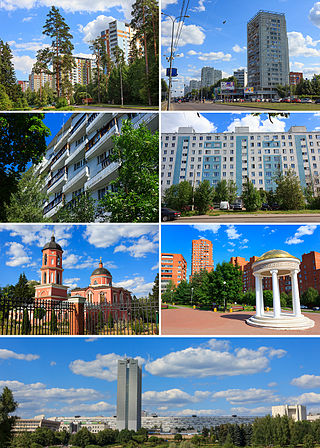
Zelenograd is a city and administrative okrug of Moscow, Russia. The city of Zelenograd and the territory under its jurisdiction form the Zelenogradsky Administrative Okrug (ZelAO), an exclave located within Moscow Oblast, 37 kilometers (23 mi) north-west of central Moscow, along the M10 highway. Zelenograd is the smallest administrative okrug of Moscow by area, the second-lowest by population, and the largest Moscow exclave by area and by population within Moscow Oblast. Zelenograd, if it were a separate settlement, would be the fifth-largest city in Moscow Oblast and one of the 100 largest cities of Russia. Before the expansion of the territory of Moscow in 2012, Zelenograd occupied second place among the administrative okrugs of Moscow, second only to the Eastern Administrative Okrug, in terms of the share of greenery in its total area.
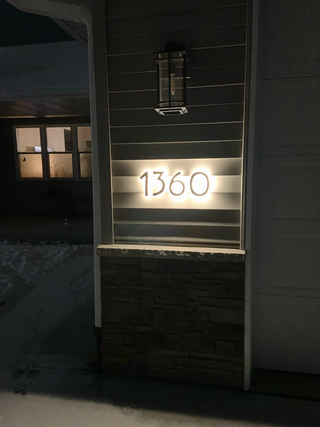
An address is a collection of information, presented in a mostly fixed format, used to give the location of a building, apartment, or other structure or a plot of land, generally using political boundaries and street names as references, along with other identifiers such as house or apartment numbers and organization name. Some addresses also contain special codes, such as a postal code, to make identification easier and aid in the routing of mail.

Russian Post is an Aktsionernoye Obschestvo which is the national postal operator of Russia. The company is responsible for the delivery of mail in Russia, and the issuing of postage stamps. Russian Post employs about 390,000 people and has over 42,000 post offices, with its headquarters in Moscow. In 2012 the Russian Post delivered more than 2.4 billion pieces of mail and accounted for more than 54 million parcels and more than 100 million in remittances. In March 2013 a presidential decree signed by President Vladimir Putin included the Russian Post in a list of so-called strategic enterprises.

Kamyshlov or Qamışlı is a town in Sverdlovsk Oblast, Russia, located on the left bank of the Pyshma River at its confluence with the Kamyshlov River. Population: 26,870 (2010 Census); 28,914 (2002 Census); 33,462 (1989 Soviet census).
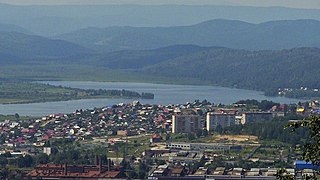
Miass is a city in Chelyabinsk Oblast, Russia, located 96 kilometers (60 mi) west of Chelyabinsk, on the eastern slope of the Southern Ural Mountains, on the bank of the river Miass. Population: 147,995 (2021 Census); 151,751 (2010 Census); 158,420 (2002 Census); 167,839 (1989 Soviet census).
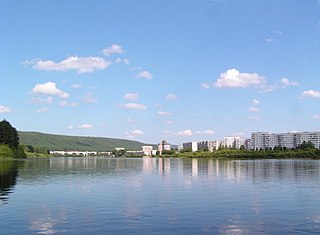
Zelenogorsk is a closed town in Krasnoyarsk Krai, Russia, located on the left bank of the Kan River 180 kilometers (110 mi) above its confluence with the Yenisei River. It was formerly known as Krasnoyarsk-45 (Красноя́рск-45) and was involved in enriching uranium for the Soviet nuclear program. Population: 66,056 (2010 Census); 69,355 (2002 Census).
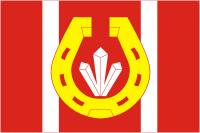
Katav-Ivanovsk is a town and the administrative center of Katav-Ivanovsky District in Chelyabinsk Oblast, Russia, located on the Katav River, 321 kilometers (199 mi) southwest of Chelyabinsk, the administrative center of the oblast. Population: 17,630 (2010 Census); 20,162 (2002 Census); 24,972 (1989 Soviet census).

Verkhneuralsk is a town and the administrative center of Verkhneuralsky District in Chelyabinsk Oblast, Russia, located in the upper streams of the Ural River, 230 kilometers (140 mi) southwest of Chelyabinsk, the administrative center of the oblast. Population: 9,457 (2010 Census); 10,054 (2002 Census); 10,893 (1989 Soviet census).

Likino-Dulyovo is a town in Orekhovo-Zuyevsky District of Moscow Oblast, Russia, located 98 kilometers (61 mi) northeast of Moscow. Population: 31,321 (2010 Census); 31,440 (2002 Census); 34,203 (1989 Soviet census).

Kotelnikovo is a town and the administrative center of Kotelnikovsky District in Volgograd Oblast, Russia, located on the Kurmoyarsky Aksay River, 190 kilometers (120 mi) southwest of Volgograd, the administrative center of the oblast. Population: 20,428 (2010 Census); 19,656 (2002 Census); 20,328 (1989 Soviet census).

Khomutovka is an urban locality and the administrative center of Khomutovsky District of Kursk Oblast, Russia. Population: 4,230 (2010 Census); 5,050 (2002 Census); 5,578 (1989 Soviet census). Telephone code: +7 47137; postal code: 307540.

Tlyarata is a rural locality in Russia. It is the administrative center of Tlyaratinsky District, Republic of Dagestan, Russia. It is located in the west of the republic of Dagestan in a mountainous area near Azerbaijan and Georgia.

Postal codes in Brunei Darussalam are known as postcodes, and they are alphanumeric; consisting of two letters followed by four digits. Postcodes in Brunei are issued by the Postal Services Department, a government department under the Ministry of Communications.

Postal codes in Cyprus have been made up of four digits since 1 October 1994. They are administered by Cyprus Post.

Sheregesh is an urban locality in Tashtagolsky District of Kemerovo Oblast, Russia. Population: 10,173 (2010 Census); 10,371 (2002 Census); 9,553 (1989 Soviet census). Postal code: 652971. The main ethnic groups are Russians and Shors.
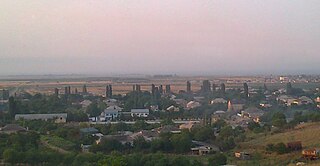
Chinar is a rural locality in Derbentsky District of the Republic of Dagestan, located in the southeastern part of the republic, 107 kilometers (66 mi) from the republic's capital Makhachkala and 5 kilometers (3.1 mi) from Dagestanskiye Ogni, where the nearest railway station is. Population: 5,227 (2010 Census); 4,357 (2002 Census); 2,908 (1989 Soviet census)..
Post codes in Mauritius consist of five digits. They were first introduced by Mauritius Post on a pilot basis, from January to March 2012, in Lallmatie, Bon Accueil and Brisée Verdière before being introduced in other localities across the island before the system went nationwide on 15 August 2014.


















